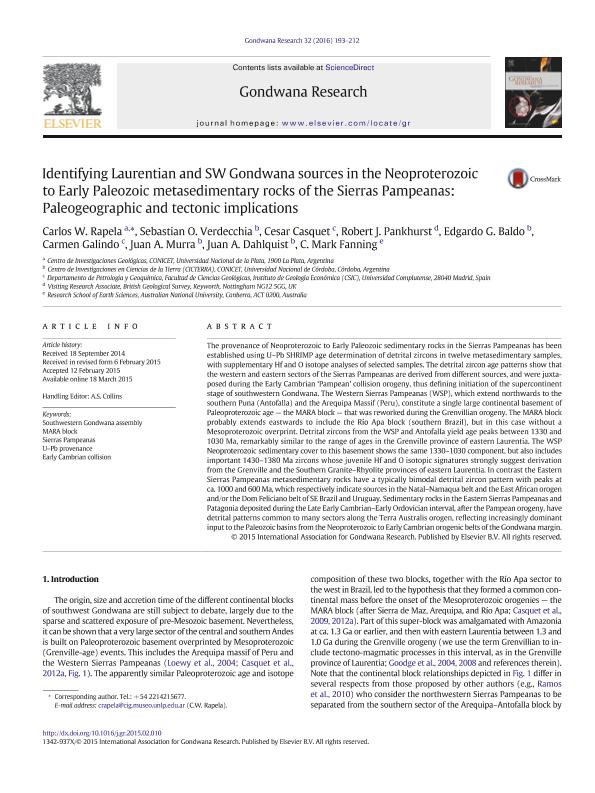Mostrar el registro sencillo del ítem
dc.contributor.author
Rapela, Carlos Washington

dc.contributor.author
Verdecchia, Sebastián Osvaldo

dc.contributor.author
Casquet, Cesar
dc.contributor.author
Pankhurst, Robert J.
dc.contributor.author
Baldo, Edgardo Gaspar Agustín

dc.contributor.author
Galindo, Carmen
dc.contributor.author
Murra, Juan Alberto Félix

dc.contributor.author
Dahlquist, Juan Andrés

dc.contributor.author
Fanning, C. Mark
dc.date.available
2018-05-03T16:45:17Z
dc.date.issued
2016-02
dc.identifier.citation
Rapela, Carlos Washington; Verdecchia, Sebastián Osvaldo; Casquet, Cesar; Pankhurst, Robert J.; Baldo, Edgardo Gaspar Agustín; et al.; Identifying Laurentian and SW Gondwana sources in the Neoproterozoic to Early Paleozoic metasedimentary rocks of the Sierras Pampeanas: Paleogeographic and tectonic implications; Elsevier Science; Gondwana Research; 32; 2-2016; 193-212
dc.identifier.issn
1342-937X
dc.identifier.uri
http://hdl.handle.net/11336/43957
dc.description.abstract
The provenance of Neoproterozoic to Early Paleozoic sedimentary rocks in the Sierras Pampeanas has been established using U–Pb SHRIMP age determination of detrital zircons in twelve metasedimentary samples, with supplementary Hf and O isotope analyses of selected samples. The detrital zircon age patterns show that the western and eastern sectors of the Sierras Pampeanas are derived from different sources, and were juxtaposed during the Early Cambrian ‘Pampean’ collision orogeny, thus defining initiation of the supercontinent stage of southwestern Gondwana. The Western Sierras Pampeanas (WSP), which extend northwards to the southern Puna (Antofalla) and the Arequipa Massif (Peru), constitute a single large continental basement of Paleoproterozoic age — the MARA block — that was reworked during the Grenvillian orogeny. The MARA block probably extends eastwards to include the Río Apa block (southern Brazil), but in this case without a Mesoproterozoic overprint. Detrital zircons from the WSP and Antofalla yield age peaks between 1330 and 1030 Ma, remarkably similar to the range of ages in the Grenville province of eastern Laurentia. The WSP Neoproterozoic sedimentary cover to this basement shows the same 1330–1030 component, but also includes important 1430–1380 Ma zircons whose juvenile Hf and O isotopic signatures strongly suggest derivation from the Grenville and the Southern Granite–Rhyolite provinces of eastern Laurentia. In contrast the Eastern Sierras Pampeanas metasedimentary rocks have a typically bimodal detrital zircon pattern with peaks at ca. 1000 and 600 Ma, which respectively indicate sources in the Natal–Namaqua belt and the East African orogen and/or the Dom Feliciano belt of SE Brazil and Uruguay. Sedimentary rocks in the Eastern Sierras Pampeanas and Patagonia deposited during the Late Early Cambrian–Early Ordovician interval, after the Pampean orogeny, have detrital patterns common to many sectors along the Terra Australis orogen, reflecting increasingly dominant input to the Paleozoic basins from the Neoproterozoic to Early Cambrian orogenic belts of the Gondwana margin.
dc.format
application/pdf
dc.language.iso
eng
dc.publisher
Elsevier Science

dc.rights
info:eu-repo/semantics/openAccess
dc.rights.uri
https://creativecommons.org/licenses/by-nc-sa/2.5/ar/
dc.subject
Southwestrn Gondwana Assembly
dc.subject
Mara Block
dc.subject
Sierras Pampeanas
dc.subject
U-Pb Provenance
dc.subject.classification
Meteorología y Ciencias Atmosféricas

dc.subject.classification
Ciencias de la Tierra y relacionadas con el Medio Ambiente

dc.subject.classification
CIENCIAS NATURALES Y EXACTAS

dc.title
Identifying Laurentian and SW Gondwana sources in the Neoproterozoic to Early Paleozoic metasedimentary rocks of the Sierras Pampeanas: Paleogeographic and tectonic implications
dc.type
info:eu-repo/semantics/article
dc.type
info:ar-repo/semantics/artículo
dc.type
info:eu-repo/semantics/publishedVersion
dc.date.updated
2018-05-02T17:42:18Z
dc.journal.volume
32
dc.journal.pagination
193-212
dc.journal.pais
Países Bajos

dc.journal.ciudad
Amsterdam
dc.description.fil
Fil: Rapela, Carlos Washington. Consejo Nacional de Investigaciones Científicas y Técnicas. Centro Científico Tecnológico Conicet - La Plata. Centro de Investigaciones Geológicas. Universidad Nacional de La Plata. Facultad de Ciencias Naturales y Museo. Centro de Investigaciones Geológicas; Argentina
dc.description.fil
Fil: Verdecchia, Sebastián Osvaldo. Consejo Nacional de Investigaciones Científicas y Técnicas. Centro Científico Tecnológico Conicet - Córdoba. Centro de Investigaciones en Ciencias de la Tierra. Universidad Nacional de Córdoba. Facultad de Ciencias Exactas Físicas y Naturales. Centro de Investigaciones en Ciencias de la Tierra; Argentina
dc.description.fil
Fil: Casquet, Cesar. Universidad Complutense de Madrid; España
dc.description.fil
Fil: Pankhurst, Robert J.. British Geological Survey; Reino Unido
dc.description.fil
Fil: Baldo, Edgardo Gaspar Agustín. Consejo Nacional de Investigaciones Científicas y Técnicas. Centro Científico Tecnológico Conicet - Córdoba. Centro de Investigaciones en Ciencias de la Tierra. Universidad Nacional de Córdoba. Facultad de Ciencias Exactas Físicas y Naturales. Centro de Investigaciones en Ciencias de la Tierra; Argentina
dc.description.fil
Fil: Galindo, Carmen. Universidad Complutense de Madrid; España
dc.description.fil
Fil: Murra, Juan Alberto Félix. Consejo Nacional de Investigaciones Científicas y Técnicas. Centro Científico Tecnológico Conicet - Córdoba. Centro de Investigaciones en Ciencias de la Tierra. Universidad Nacional de Córdoba. Facultad de Ciencias Exactas Físicas y Naturales. Centro de Investigaciones en Ciencias de la Tierra; Argentina
dc.description.fil
Fil: Dahlquist, Juan Andrés. Consejo Nacional de Investigaciones Científicas y Técnicas. Centro Científico Tecnológico Conicet - Córdoba. Centro de Investigaciones en Ciencias de la Tierra. Universidad Nacional de Córdoba. Facultad de Ciencias Exactas Físicas y Naturales. Centro de Investigaciones en Ciencias de la Tierra; Argentina
dc.description.fil
Fil: Fanning, C. Mark. Australian National University; Australia
dc.journal.title
Gondwana Research

dc.relation.alternativeid
info:eu-repo/semantics/altIdentifier/url/https://www.sciencedirect.com/science/article/pii/S1342937X1500057X?via%3Dihub
dc.relation.alternativeid
info:eu-repo/semantics/altIdentifier/doi/https://doi.org/10.1016/j.gr.2015.02.010
Archivos asociados
